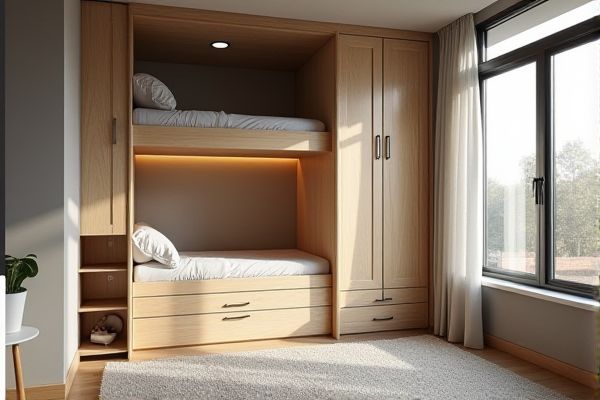
Murphy beds provide space-saving convenience by folding vertically against the wall, making them ideal for small rooms or multifunctional spaces, while loft beds elevate your sleeping area to free up floor space underneath for a desk or storage. Explore the rest of the article to discover which option best fits Your lifestyle and space needs.
Table of Comparison
| Feature | Murphy Bed | Loft Bed |
|---|---|---|
| Space Saving | Folds vertically into wall, maximizes floor space when not in use | Elevates bed to free floor space for desk or storage underneath |
| Installation | Requires sturdy wall mounting, professional installation recommended | Requires stable frame assembly, easier DIY installation |
| Functionality | Bed folds away completely; best for multi-use rooms | Permanent raised bed; ideal for small rooms and kids' spaces |
| Weight Capacity | Typically supports standard mattress and user weight | Depends on frame; often supports lighter weight than Murphy beds |
| Cost | Generally higher due to custom design and installation | Usually more affordable and widely available |
| Design Options | Customizable finishes; blends with cabinetry or walls | Variety of styles focused on youth and casual rooms |
| Accessibility | Easy bed access without climbing | Requires climbing ladder or stairs |
Introduction to Murphy Beds and Loft Beds
Murphy beds maximize space by folding vertically into a wall or cabinet, ideal for small apartments or multifunctional rooms. Loft beds elevate the sleeping area, creating usable space underneath for desks, storage, or seating, making them popular in dormitories and children's rooms. Both solutions optimize limited square footage without sacrificing comfort or style.
Space-Saving Design Comparison
Murphy beds fold vertically against the wall, maximizing floor space by completely clearing the area when not in use, making them ideal for multifunctional rooms. Loft beds elevate the sleeping area, freeing up space underneath for desks, storage, or seating, which works well in small bedrooms or studio apartments. Your choice depends on whether you prefer a fully open floor during the day (Murphy bed) or a constant elevated sleeping platform with usable space below (loft bed).
Comfort and Mattress Options
Murphy beds offer greater comfort flexibility by supporting standard mattress sizes such as memory foam, innerspring, or hybrid, allowing for personalized sleep preferences. Loft beds typically accommodate thinner, more lightweight mattresses designed for space efficiency, which may compromise cushion thickness and pressure relief. Choosing between the two depends on prioritizing mattress quality and comfort over space-saving features.
Suitability for Different Room Types
Murphy beds are ideal for small apartments or multi-purpose rooms where floor space must be conserved, as they fold vertically into the wall, freeing the entire floor area when not in use. Loft beds suit rooms with higher ceilings, such as studio apartments or dormitories, by elevating the sleeping area to create usable space underneath for a desk, seating, or storage. Your choice depends on room height and desired floor usability, with Murphy beds offering maximal open space and loft beds maximizing vertical space.
Installation and Assembly
Murphy beds require secure wall mounting and precise installation to ensure safety and smooth operation, often needing professional assistance due to their complex mechanisms. Loft beds involve simpler assembly, typically constructed from metal or wood frames and assembled in your room without wall attachment, making them more DIY-friendly. Your choice depends on available space and your comfort level with detailed installation steps.
Storage Features: Which Offers More?
Murphy beds typically provide less built-in storage but free up floor space when folded, allowing for additional standalone storage furniture in a room. Loft beds often include integrated storage options such as drawers, shelves, and desks beneath the elevated sleeping area, maximizing vertical space utilization. For rooms requiring multifunctional storage, loft beds generally offer more dedicated storage features than Murphy beds.
Cost and Budget Considerations
Murphy beds typically cost between $1,000 and $3,000 due to their complex wall-mounting mechanisms and custom cabinetry, making them a higher-budget option. Loft beds, often priced around $200 to $800, provide a more affordable solution, especially for small spaces or children's rooms. Your budget and space requirements will heavily influence the choice between the upfront investment of a Murphy bed and the economical, space-saving benefits of a loft bed.
Safety and Accessibility
Murphy beds offer enhanced safety with sturdy wall-mounted mechanisms that ensure secure folding and storage, reducing the risk of accidental falls, while loft beds pose potential hazards due to elevated sleeping areas requiring secure railings and ladders. Accessibility on Murphy beds is superior for individuals with limited mobility, as they fold down to floor level without the need to climb, making your space more user-friendly. Loft beds may limit accessibility for children or older adults, necessitating careful consideration of ladder design and ease of access.
Style and Customization Options
Murphy beds offer sleek, space-saving designs that can seamlessly blend into your room's decor, often featuring customizable cabinetry and finishes to match your style preferences. Loft beds provide elevated sleeping areas with versatile options underneath for desks, storage, or seating, allowing you to personalize the space for functionality and aesthetics. Your choice between these beds depends on how much you want to customize the look and maximize room layout efficiency.
Pros and Cons Summary
Murphy beds maximize floor space by folding vertically into a wall, offering a sleek, space-saving solution ideal for small apartments, but they require wall installation and can be costly. Loft beds elevate the sleeping area to free up room underneath for desks or storage, promoting multifunctionality but potentially limiting headroom and requiring ladder access. Choosing between Murphy and loft beds depends on specific spatial needs, budget, and preferences for accessibility versus floor-level sleeping comfort.
 homyna.com
homyna.com